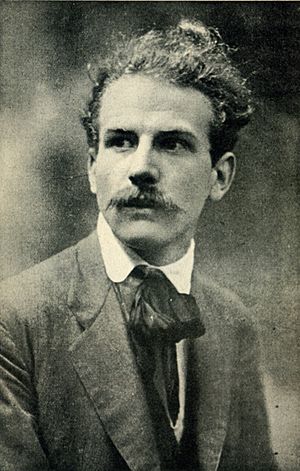Scipio Slataper facts for kids
Quick facts for kids
Scipio Slataper
|
|
|---|---|
 |
|
| Born | 14 July 1888 Trieste, Austrian Littoral, Austro-Hungarian Empire (now in Italy) |
| Died | 3 December 1915 (aged 27) Podgora near Gorizia, County of Gorizia and Gradisca, Austria-Hungary (now in Italy) |
| Occupation | essayist, novelist, literary critic |
| Nationality | Italian |
| Genre | essays, autobiography, travel literature |
| Literary movement | Modernism |
Scipio Slataper (born July 14, 1888 – died December 3, 1915) was an Italian writer. He is most famous for his lyrical essay My Karst. Many people see him, along with Italo Svevo, as a key figure who started the rich tradition of Italian writing in Trieste.
Contents
A Young Writer's Life
Scipio Slataper was born in Trieste on July 14, 1888. At that time, Trieste was part of the Austro-Hungarian Empire, but today it is in Italy. His family was quite well-off and belonged to the middle class.
After finishing high school in his hometown, Scipio moved to Florence, Italy. There, he studied Italian philology, which is the study of language and literature.
Writing in Florence
While in Florence, Scipio started working with a literary magazine called La Voce. This magazine was run by important writers like Giuseppe Prezzolini and Giovanni Papini.
Scipio began writing essays and articles about the culture and literature of Trieste. He stayed in close touch with his hometown. He also worked with young Italian thinkers from the Austrian Littoral. Some of these friends lived in Italy, while others stayed in their home region.
Scipio's group of friends included many talented people. Among them were the journalist Giulio Caprin, the writer Giani Stuparich, his wife Elody Oblath, and his brother Carlo Stuparich. Other friends were the literary critic Silvio Benco and poets like Umberto Saba, Virgilio Giotti, and Biagio Marin.
My Karst and Its Impact
Scipio Slataper's most famous work is My Karst. He published this essay in Florence in 1912. It was the only book he published during his lifetime.
In My Karst, Scipio explored ideas about life force and nature. He also shared his thoughts on politics and philosophy. He was critical of some of the business people in Trieste. He felt they were too focused on money and had unfair ideas about other groups of people. He also wrote about the local Slovene peasants and their way of life.
In 1921, My Karst was translated into French. This helped Scipio Slataper become more well-known across Europe in the 1920s.
Later Life and War
After graduating in 1912, Scipio Slataper moved to Hamburg, Germany. He taught Italian at the local university there.
When Italy declared war on Austria-Hungary on May 24, 1915, Scipio returned to Italy. He volunteered to join the Italian Army. He was sent to fight on the front lines along the Isonzo River.
Sadly, in December 1915, Scipio Slataper was killed. He died during the Fourth Battle of the Isonzo in the hills near the town of Gorizia.
Scipio's Lasting Influence
Scipio Slataper played a very important role in creating a unique style of writing in Trieste. Many later authors were influenced by him. These include Giani and Carlo Stuparich, Fulvio Tomizza, Enzo Bettiza, Susanna Tamaro, and Claudio Magris. He also influenced some Slovene writers, such as Marjan Rožanc and Igor Škamperle.
Main Works
- Il mio Carso. Florence: Libreria della Voce, 1912 (My Karst and My City and Other Essays. Edited, with an Introduction and Notes, by Elena Coda. Translated by Nicholas Benson and Elena Coda. Toronto: University of Toronto Press, 2020).
- I confini necessari all'Italia. Turin: L'Ora Presente, 1915.
See also
 In Spanish: Scipio Slataper para niños
In Spanish: Scipio Slataper para niños
- Carlo Michelstaedter

